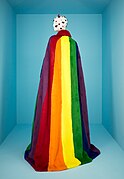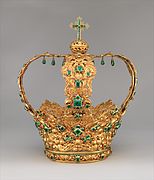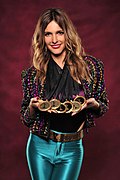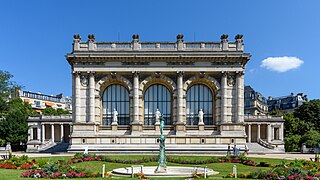The Fashion Portal
 | |

| |
Fashion is a term used interchangeably to describe the creation of clothing, footwear, accessories, cosmetics, and jewellery of different cultural aesthetics and their mix and match into outfits that depict distinctive ways of dressing (styles and trends) as signifiers of social status, self-expression, and group belonging. As a multifaceted term, fashion describes an industry, styles, aesthetics, and trends.
The term 'fashion' originates from the Latin word 'Facere,' which means 'to make,' and describes the manufacturing, mixing, and wearing of outfits adorned with specific cultural aesthetics, patterns, motifs, shapes, and cuts, allowing people to showcase their group belonging, values, meanings, beliefs, and ways of life. Given the rise in mass production of commodities and clothing at lower prices and global reach, reducing fashion's environmental impact and improving sustainability has become an urgent issue among politicians, brands, and consumers. (Full article...)
Selected article -

Body piercing, which is a form of body modification, is the practice of puncturing or cutting a part of the human body, creating an opening in which jewellery may be worn, or where an implant could be inserted. The word piercing can refer to the act or practice of body piercing, or to an opening in the body created by this act or practice. It can also, by metonymy, refer to the resulting decoration, or to the decorative jewelry used. Piercing implants alter the body and/or skin profile and appearance (e.g. golden threads installed subdermal, platinum, titanium or medical grade steel subdermal implants). Although the history of body piercing is obscured by popular misinformation and by a lack of scholarly reference, ample evidence exists to document that it has been practiced in various forms by multiple sexes since ancient times throughout the world. Body piercing can be performed on people of all ages, although most minors [where?] are only permitted to have earlobe piercings.
Ear piercing and nose piercing have been particularly widespread and are well represented in historical records and among grave goods. The oldest mummified remains ever discovered had earrings, attesting to the existence of the practice more than 5,000 years ago. Nose piercing is documented as far back as 1500 BCE. Piercings of these types have been documented globally, while lip and tongue piercings were historically found in African cultures and many more but is actually from the Middle East. Nipple and genital piercing have also been practiced by various cultures, with nipple piercing dating back at least to Ancient Rome while genital piercing is described in Ancient India c. 320 to 550 CE. The history of navel piercing is less clear. The practice of body piercing has waxed and waned in Western culture, but it has experienced an increase in popularity since World War II, with sites other than the ears gaining subcultural popularity in the 1970s and spreading to the mainstream in the 1990s. (Full article...)Core topics -

Footwear refers to garments worn on the feet, which typically serve the purpose of protection against adversities of the environment such as wear from rough ground; stability on slippery ground; and temperature.
- Shoes and similar garments ease locomotion and prevent injuries. Such footwear can also be used for fashion and adornment, as well as to indicate the status or rank of the person within a social structure.
- Socks and other hosiery are typically worn additionally between the feet and other footwear for further comfort and relief.
Cultures have different customs regarding footwear. These include not using any in some situations, usually bearing a symbolic meaning. This can however also be imposed on specific individuals to place them at a practical disadvantage against shod people, if they are excluded from having footwear available or are prohibited from using any. This usually takes place in situations of captivity, such as imprisonment or slavery, where the groups are among other things distinctly divided by whether or not footwear is being worn.
In some cultures, people remove their shoes before entering a home. Bare feet are also seen as a sign of humility and respect, and adherents of many religions worship or mourn while barefoot. Some religious communities explicitly require people to remove shoes before they enter holy buildings, such as temples. (Full article...)Featured picture -

A photo of two maiko (apprentice geisha), with the typical make-up clearly visible, leaving portions of the nape uncovered. This is done to accentuate what is a traditionally erotic area. The white face make-up is supposed to resemble a mask, and a line of bare skin around the hairline helps create that illusion. Established geisha generally wear full white face makeup characteristic of maiko only during special performances.
Did you know... -
- ...that parti-coloured clothes, divided into different colours on the left and right when viewed from the front (pictured), became popular in late 14th century fashion, especially in England?
- ... that red carpet fashion in 2002 included transparent bodices and phlegm and dung coloured tulle?
- ... that Senegalese fashion designer Adama Ndiaye organized the Dakar Fashion Week exhibition, now in its 10th year?
Selected biography -
General images
Lua error: No content found on page "Women's beachwear fashion".
More Did you know (auto generated)

- ... that a scene from the television adaptation of the manga It's All About the Looks was filmed at the Tokyo Girls Collection fashion show?
- ... that during the Second World War, the British government's campaign Make-Do and Mend encouraged the public to fashion men's clothes into womenswear?
- ... that chemist Betty Lou Raskin said in 1958 that society was wasting the "brainpower" of women, and blamed the media for making the mink coat the "symbol of female success" and not the lab coat?
- ... that Malika Louback believes her three engineering degrees make her a better fashion model?
- ... that Carlisle miser Margery Jackson, who chose to live like a pauper, possessed a fine court mantua?
- ... that radio station WIQT near Elmira, New York, was co-owned with a regional group of clothing, furniture, and shoe stores?
Selected quote -
Related portals
Topics
Featured content
Categories
Things you can do
- Fill out the red links on Portal:Fashion/Selected anniversaries
Wikimedia
The following Wikimedia Foundation sister projects provide more on this subject:
-
Commons
Free media repository -
Wikibooks
Free textbooks and manuals -
Wikidata
Free knowledge base -
Wikinews
Free-content news -
Wikiquote
Collection of quotations -
Wikisource
Free-content library -
Wikiversity
Free learning tools -
Wiktionary
Dictionary and thesaurus




































